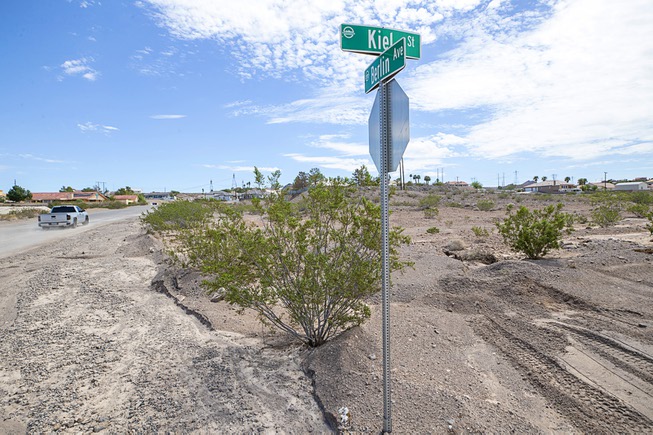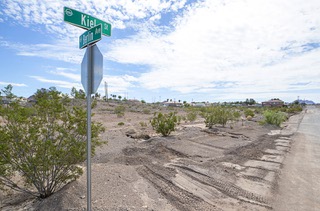
A pickup truck heads southbound on Berlin Avenue by Kiel Street in Henderson Tuesday, Aug. 16, 2022. The land at right is the site for a future Hindu temple.
Sunday, Sept. 11, 2022 | 2 a.m.
Baba Anal’s house in the Anthem area of Henderson often serves as a makeshift worship center for some residents practicing Hinduism.
He teaches breathing classes and offers followers a place to perform the meditation, silent prayers and yoga that are part of worshiping.
If it weren’t for Anal opening his home, some of the area’s roughly 300 Hindus might not have a place to participate in their faith; there are just two Hindu temples in the Southern Nevada and both are in Las Vegas.
That could soon change.
The Henderson Planning Commission on a 4-1 vote last month approved a proposal from the American Hindu Association to construct a temple at Berlin Avenue and North Milan Street near Racetrack Road.
But residents are appealing to the Henderson City Council because they say it will take away from the “rural feel” of their part of east Henderson and bring traffic to a neighborhood where children often play in the street. It’s common to find residents riding a horse or driving an off-road vehicle on the wide streets in the area that many have called home for decades. The issue is scheduled to come before the council on Sept. 20. (Editor's note: The issue has been moved to a future agenda)
Bob Lendzion, who owns property near the proposed temple site, said the complex would “interfere with the peaceful enjoyment” in an area with hundreds of ranch-style homes.
“What kind of precedence does this set for the neighborhood? This is a neighborhood,” he said.
State or federal law?
The Nevada Legislature in 1999 approved Senate Bill 391 that authorizes jurisdictions to adopt zoning regulations and other restrictions to protect rural preservation in neighborhoods. The legislation, which also ensures the orderly transition of land uses, was in response to the growth experienced in Southern Nevada at the turn of the century.
Residents argue the temple complex proposal violates this legislation. They stress a neighborhood is no place for a commercial building, whether that’s a business or a temple. The complex, which includes a temple and a secondary building to serve as a residence for officials, is proposed over 5 acres.
“There’s 105 parking spaces at the facility. How does that fit into the character of my neighborhood?” resident Kayla Calvert asked the planning commission. “Rob us of our peace, low traffic and noise. (It’s) unfair to me, my family and my neighbors.”
In approving the proposal the planning commission cited the Religious Land Use and Institutionalized Persons Act, a federal civil rights law “that protects individuals and religious assemblies and institutions from discriminatory and unduly burdensome land-use regulations.”
The act “takes precedence” over any local land use codes during conflicts, such as the one that arose with this project, said Kathleen Richards, a spokesperson for the city of Henderson.
While the act can open doors for religious institutions, these sites can still be denied if the city shows there is “a compelling governmental interest for the restriction” by creating “some substantial threat to public safety, peace or order,” Richards said.
The government must also show that “it is using the means that are least restrictive of religious freedom,” even if the government can argue that the religious institution poses a threat to the public.
“Based on court decisions interpreting (the act), it is clear that it would be difficult to find the type of compelling interest that would allow a denial of the religious assembly in this case,” Richards said.
About 80 residents attended the planning commission meeting to speak out against the proposal, with many saying they didn’t oppose the Hindu faith — just where its house of worship would be located. One commenter said he wouldn’t want a church of his faith built in the neighborhood because of the same traffic concerns.
“This is not really the place for this facility,” resident Becky Ramirez told the commission. “It is deeply in the middle of our neighborhood. I just don’t feel this is the right place for it. There’s just no need to put it in this neighborhood where there’s children playing, horses, people riding their off-road vehicles.”
A few neighbors disagreed.
Roxanne Ortega, who has lived in the area since 1963, said the temple would be a welcome addition to the community. “This is a wonderful place of worship that should be welcomed,” she said.
One practitioner of Hinduism, who travels 25 minutes from his house at Valle Verde Drive and Windmill Parkway to attend the Hindu and Jain Temple of Las Vegas near Summerlin, told the residents, “I assure you that after one year you will say you did the right thing for us.”
‘Happy Temple’
Referred to as the Anand Utsav Mandir-Temple Complex, or “Happy Temple,” the American Hindu Association’s plans also call for the campus to include a multipurpose building, an additional assembly space for worship, a storage shed, and roughly 105 parking spaces.
Organizers said the temple would be open about seven hours daily for individual prayer, hold one formal prayer on the second Sunday of each month, and host six annual festivals.
The association “assured” the planning commission it would limit the number of people at the temple to 20 on any given day, even during its large events.
Simona Stephens, the project architect, said that architects have changed the temple’s design so that it can operate at the “bare minimum” for a religious place of worship. After meeting with residents in April, who gave the association no suggestions other than to “not build a temple there,” Stephens and the association did “absolutely everything” to make sure the project would be a “clean application” to the city of Henderson.
After meeting with city officials, Stephens said the plans were amended from eight buildings to five. Additionally, there are no plans for sidewalks — one of the concerns of residents because it would take away from the rural feel of the area.
Baba, who wasn’t available to comment, is the “main priest — the owner of the property,” Stephens said. “It’s going to be their main residence, he’ll be living on the site. He’s going to be neighbors with these people.”
Those who know Baba told the commission he had done a good amount of philanthropy and would continue doing so with the facility.
Saroj Singh, a Summerlin resident who attends the Hindu and Jain Temple, said, “(Hindus) are very peaceful… and (they) respect other people,” so they will not be as disruptive as many of the Henderson residents believe. He also believes the temple will add some diversity to the neighborhood.
“I think (the temple) will be good for the kids,” Singh said. “They’ll be more open to other religions, other things, and they’ll understand that.”
Keep it ‘countrified’
Autumn Hood, who can see the proposed temple site from her backyard on the corner of North Lisbon Street, created a website “Neighbors of the RNP 89015” where she shares updates on the project.
The neighbors are drafting an appeal asking the city to reevaluate planning commission’s decision, citing that the “federal restriction doesn’t govern like an umbrella” and the planning committee was “way too relaxed on their interpretation of the law.”Hood said the safety of her two young children was her motivation to be outspoken. She speculates the temple could be at rist for anti-religious terrorist attacks that would put her kids in danger. Hindu temples have been vandalized in Washington, Texas and Kentucky in recent years.
Patrick Bryant, whose backyard would overlook the temple, is against the temple because he feels it would decrease his property value. Bryant, 81, has lived at his property for almost 30 years.
With custom-built houses and a “countryfied” location that lacks urban details like street lighting, Bryant said that “there’s a lot of money invested” in the neighborhood, but he believes the temple will bring urban aspects to an area chosen by residents for its rural environment.
“We can appeal it, but knowing those (planning commissioners) down there, you can’t do anything about it,” Bryant said. “It’s not a neighborhood (issue) anymore, it’s federal.”

